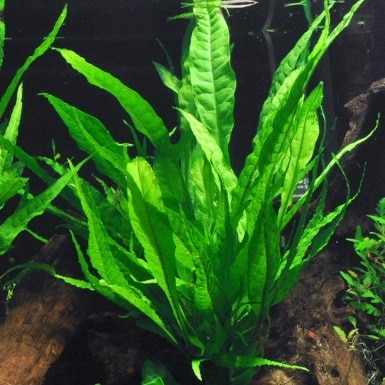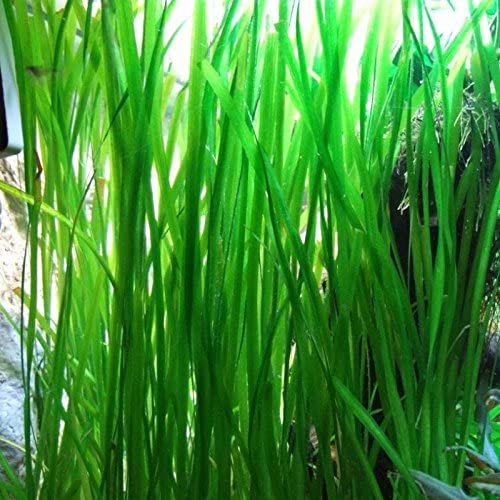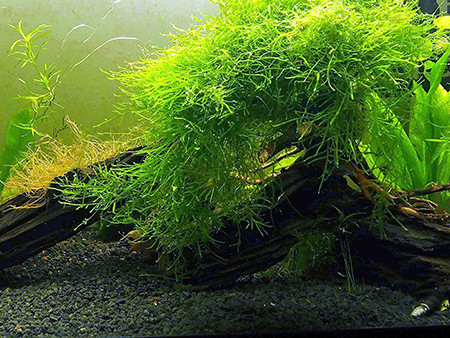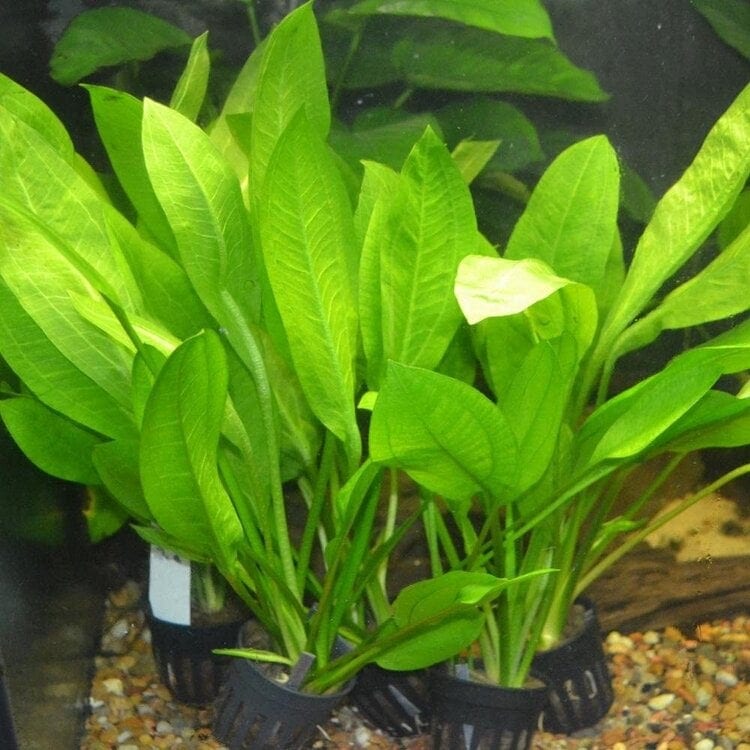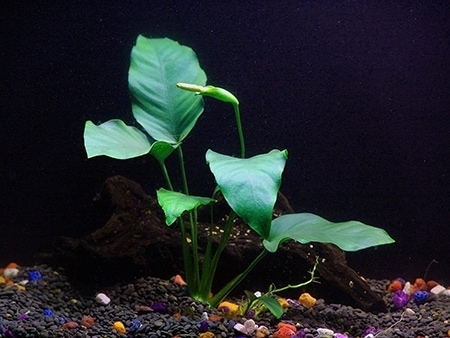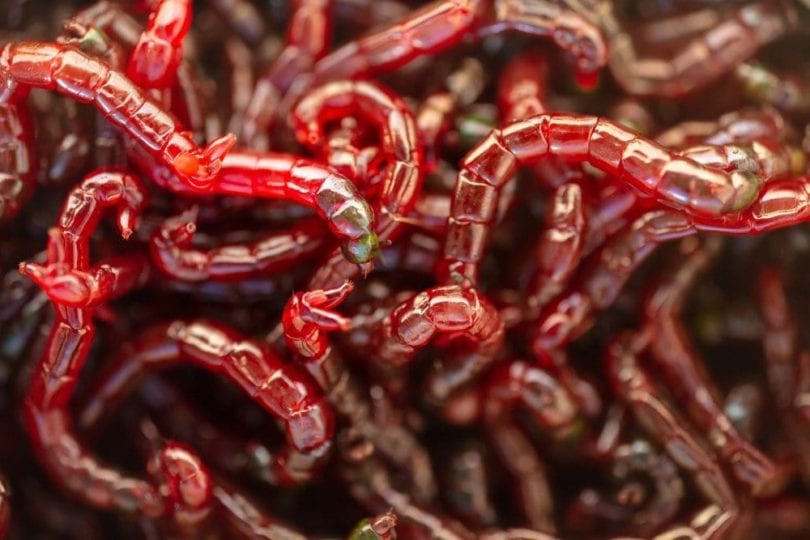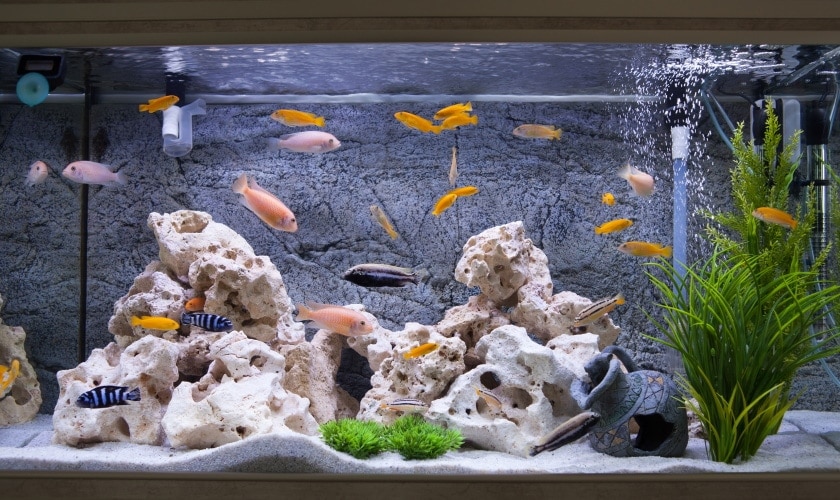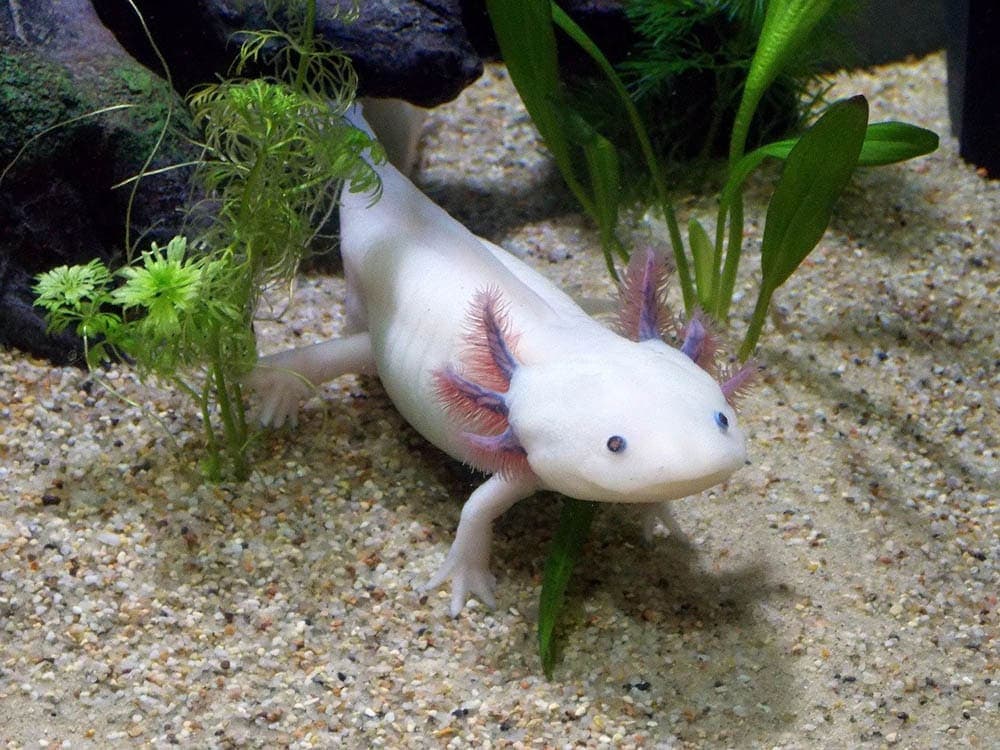7 Best Aquarium Plants For Angelfish in 2024: Reviews & Top Picks

Updated on
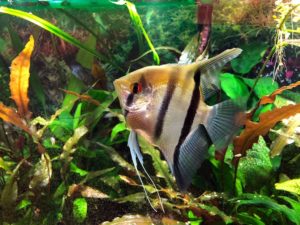
The fact of the matter is that any and all aquariums look much better with real live plants. A good mix of plants brings many benefits to any aquarium, and yes, angelfish should definitely be kept with some plants.
Today, we want to help you find the best plants for angelfish; not all plants are ideal for these fish, so it’s important to add the right ones to your tank to provide them with some cover and potentially somewhere for them to lay their eggs. We have narrowed it down to seven that are our personal favorites.

A Quick Comparison of Our Favorites in 2024
| Rating | Image | Product | Details | |
|---|---|---|---|---|
| Best Overall |
 |
Java Fern |
|
Check Price |
 |
Jungle Vallisneria |
|
Check Price | |

|
Java Moss |
|
Check Price | |

|
Water Wisteria |
|
Check Price | |
|
|
Water Sprite |
|
Check Price |
The 7 Best Aquarium Plants For Angelfish
There are quite a lot of decent plant options out there, but here are our favorite seven options and why. We have also included some important information for each plant, such as temperature, growth rate/size, and the ideal conditions for the plant to flourish.
1. Java Fern
| Care Level: | Easy |
| Light: | Low |
| Substrate: | Not required (Rhizome) |
The java fern is definitely a good option to go with for a planted angelfish tank. This is a fairly hardy plant that can survive in various conditions and is quite easy to care for. It’s a good option to go with for angelfish because it will provide them with some leaves on which they can lay their eggs on if breeding and spawning is something you hope for.
Moreover, it’s also a good plant for angelfish because they can rest on the leaves a little bit if they so choose, and it also provides them with something to swim through, and when the java fern gets a bit larger, something to hide under as well.
The java fern does not need an overly large tank, which is a bonus, and it’s quite easy to deal with as well. It features rhizomes that require tying to rocks or driftwood, but it can also survive in aquarium gravel if need be.
It can grow to 14 inches in height, so you may need to trim it depending on tank size, but it does not grow too quickly, so there is that. This plant requires the water temperature to be between 68 and 82 degrees Fahrenheit, with a pH level between 6.0 and 7.5 and a water hardness level between 3 and 8 dGH, all of which work fine for an angelfish tank.
Due to it’s size, the java fern does make for a better background plant than anything else.
- Goldfish Proof Score: 90%
- Water Purifying Score: 60%
- Easy to care for
- Inexpensive
- Hardy
- Does not need to be planted in substrate
2. Jungle Vallisneria
| Care Level: | Easy |
| Light: | Low to medium |
| Substrate: | Sand, soil, & quartz |
Jungle Vallisneria is a nice option to go with for angelfish tanks as well. Now, this stuff looks more or less like very large grass.
It features long, very thin, green leaves that come to a point at the end, more or less like normal grass you would see anywhere, but of course, it is aquatic grass. What you do need to know about Jungle Vallisneria is that it can grow very large, up to 6 feet in height, and it does grow pretty quickly, especially under the right conditions.
Therefore, this particular plant is best used in larger aquariums, especially tall aquariums that will allow the Jungle Vallisneria to grow to a decent height. Of course, you can trim it if need be, so there is always that.
Jungle Vallisneria is a nice plant for angelfish tanks because it does spread outwards at a decent pace, and it creates an area of tall grass where the angelfish can hide in, play in, and swim through as well.
It helps provide some cover and privacy whenever needed. In terms of care and tank conditions, Jungle Vallisneria can survive in waters between 64 and 82 degrees Fahrenheit, it does fine in pH levels anywhere from 6.0 to 9.0, and it does not need too much light either, all of which works just fine in any angelfish tank.
Keep in mind that this is a rooted plant, so you will want some decent aquarium gravel to keep the root system happy and healthy.
- Goldfish Proof Score: 60%
- Water Purifying Score: 90%
- Good background or ‘filler’ plant
- Inexpensive
- Hardy
- Great for water purity
3. Java Moss
| Care Level: | Easy |
| Light: | Medium |
| Substrate: | Not required (floating) |
Java moss is another good option to go with for angelfish. This stuff is very soft and creates a mossy carpet anywhere you put it. It kind of looks like a mix between moss and a fern, as it created that classic mossy look, with all of the leaves looking like little miniature ferns.
What’s nice about this stuff is that you can tie it down to any rock or piece of driftwood, and it will slowly grow to cover anything. It does not like being buried, as it has rhizomes, not roots, so you should aim to always tie it to something like driftwood, not try to plant it in sand or gravel, as it will not grow well this way.
With all of that said, java moss is great for angelfish because it is soft and non-obtrusive, and it provides a soft bed for angelfish to lay their eggs on or just to rest on if need be. Java moss is also a good option for angelfish tanks because it is very easy to care for.
It has a fairly low growth rate, so trimming needs are minimal, and it grows well in both low and high light conditions. In terms of temperature, java moss can handle anywhere from 59 to 86 degrees Fahrenheit, and in terms of pH, anywhere between 5.0 and 8.0 is just fine.
- Goldfish Proof Score: 90%
- Water Purifying Score: 50%
- Easy to care for
- Inexpensive
- Best for both tropical and cold-water
- Substrate not required
4. Water Wisteria
| Care Level: | Easy |
| Light: | Medium |
| Substrate: | Sand or fine gravel |
Water wisteria is yet another great option to keep in mind for angelfish tanks, especially large aquariums with plenty of room to spare. This is a rooted plant, so you will need to root it in some good aquarium gravel. It’s not one of those plants that you can just tie to driftwood.
Now, water wisteria can get quite large, up to 10 inches wide and 20 inches tall, so it is best for larger tanks. However, you can trim it down to size relatively easily, and therefore, you could use it as a background plant and leave it to grow, or you can use it as a midground or foreground plant if you keep it trimmed neatly. This plant features green leaves, bright green, with narrow protrusions that eventually come to a point.
It’s a really leafy plant that provides angelfish with good hiding spaces, and yes, the leaves can support angelfish eggs as well. If you let it get taller, it will also help provide your angelfish with some privacy and a place to hide.
What’s nice about water wisteria is that it’s quite easy to care for and can handle a lot of beginner mistakes. It does well in waters between 70 and 82 degrees Fahrenheit, with a pH level between 6.5 and 7.5 and a water hardness level between 2 and 8 dGH, all of which coincides with what angelfish require.
One thing to note here however is that water wisteria does require a good deal of light to grow properly and to be healthy.
- Goldfish Proof Score: 70%
- Water Purifying Score: 90%
- Rapid growth
- Inexpensive
- Excellent foreground and filler plant
- Great for water purity
5. Water Sprite
| Care Level: | Easy |
| Light: | Medium |
| Substrate: | Sand or gravel |
The other plant that we would recommend going with for an angelfish tank is water sprite. Water sprite is a good option because it has lots of really long and narrow stems with leaves, and it can form a pretty thick wall, which is perfect for angelfish to swim through, to hide in, to get some privacy, and to lay eggs in as well, if need be.
Now, water sprite can get fairly large, up to around 13 inches in height, so it is best used for larger fish tanks and as a background plant. However, you can easily trim it down to size, and if you keep it trimmed, it will do just fine for smaller tanks and as a midground or foreground plant.
It grows at a pretty slow pace, so that helps as well. Water wisteria does just fine in basic aquarium gravel, which is another bonus to keep in mind. This stuff is also quite hardy and resilient and quite easy to care for.
In terms of care and tank conditions, temperatures between 68 and 82 degrees Fahrenheit, a pH level between 6.0 and 7.5, and a water hardness level between 3 and 8 dGH are required, all of which coincide with the needs of angelfish.
- Goldfish Proof Score: 90%
- Water Purifying Score: 80%
- Temperature tolerant
- Slow and steady growing
- Hardy
- Great for water purity
6. Amazon Sword
| Care Level: | Easy |
| Light: | Low to medium |
| Substrate: | Sand, gravel, & quartz |
The Amazon sword is another great plant to have in an angelfish tank. This is a plant that is very easy to grow, and its maintenance requirements are very minimal.
It can survive in waters of various temperatures and pH levels. It requires a medium amount of light. Moreover, this plant has a medium growth rate, so it won’t overtake a tank too quickly.
The large green leaves that the Amazon sword plant features not only look nice, but they make for some great cover from above as well. It doesn’t grow too fast or too large, making it an ideal plant for most aquariums.
- Goldfish Proof Score: 90%
- Water Purifying Score: 60%
- Does not overgrow in aquariums
- Temperature and pH tolerant
- Hardy
- Great center focus plant
7. Anubias
| Care Level: | Easy |
| Light: | Low |
| Substrate: | Sand and fine gravel |
The anubias barteri is another great plant to have in an angel fish tank, mainly because it is so easy to grow and maintain.
This plant does not grow tall at all, it tends to grow in width more than in height, and it has a slow growth rate, too. All of these things make it not only easy to maintain but also make it ideal for fairly small tanks.
Anubias can survive in varying water conditions, both in terms of pH and temperature, and they don’t require much light either. They have nice, round, green leaves and make for perfect angelfish plants.
- Goldfish Proof Score: 90%
- Water Purifying Score: 70%
- Minimal care requirements
- Good bottom-level plant
- Tolerant to a wide range of water conditions
- Great for water purity
Buyer’s Guide: Picking the Best Aquarium Plant For Angelfish
Angelfish Aquascape Tips
Creating the perfect aquascape for angelfish is not overly difficult. One of the most important aquascaping tips for these small and peaceful fish is to provide them with plenty of plants.
These fish love hiding under cover, and large-leafed plants are perfect for this.
Be sure that their aquascape also features slow-flowing water, as they don’t like strong currents, and be sure to provide them with a decent amount of light too.
What is the best substrate for Angelfish?
Gravel and rocks should not be used for angelfish substrate, as they have fairly fragile fins, and they sometimes like to root around in substrate.
Rough or sharp substrate may injure them. Angelfish prefer soft sand or even mud as substrate.
This kind of substrate will be able to make angelfish feel at home, as in the wild, they often live in flooded forests that are muddy and/or sandy.
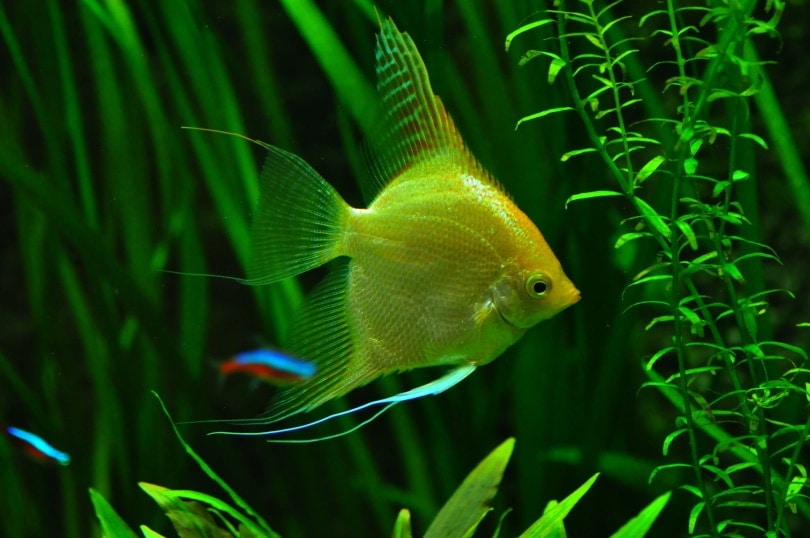
Do Angelfish Need Live Plants?
Okay, so technically speaking, angelfish do not require live plants to grow or to survive. Sure, fake plants could do just fine as long as they provide your angelfish with some cover, something to swim through, and somewhere to lay their eggs on.
However, plastic and other fake plants just don’t look very nice, they don’t clean or filter water, and angelfish may be able to tell that something weird is up with them.
For the most part, yes, you should get real live plants for angelfish tanks, something for the angelfish to get some cover under, to rest on, and lay their eggs on.
Real plants also come with the advantage of filtering water to a certain degree, and they just look much nicer too. So yes, it is recommended to get live plants for your angelfish tank.
Do Angelfish Eat Plants?
This is kind of a hard question to answer, as some angelfish will try to munch on some aquarium plants and others will not.
Some angelfish will try to eat some plants, especially when they are maturing or spawning, but for the most part, they should leave plants alone. This can be a matter of personal preference.
Some angelfish may prefer eating some plants over others, and some may not like eating any plants at all.
It depends on the specific fish in question, and it may require you to go through a trial and error process to see which plants your fish like to eat and which ones they will leave alone. If you need some food suggestions, then take a look at this article.
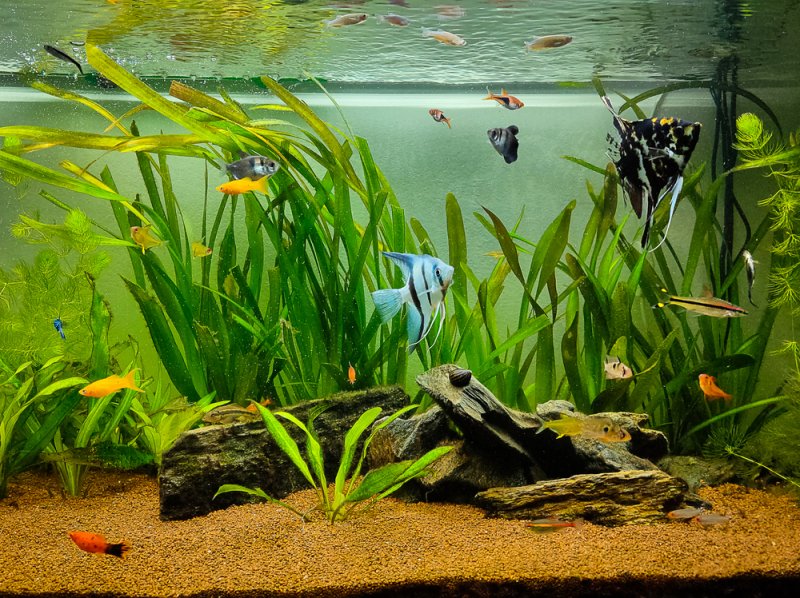
Do Angelfish eat duckweed?
Although it is not their favorite snack, angelfish will occasionally munch out on duckweed.
They usually won’t go near the stuff, but some fish will, and no worries, because it is perfectly safe for them to eat.
Conclusion
Just remember that angelfish often like tall grasses and plants with big leaves, really anything they can use for some cover or just to lay eggs on as well. As long as the tank requirements of the angelfish and the plants in question are similar, you should not have any problems in that regard.
Featured Image Credit: You Touch Pix of EuToch, Shutterstock



